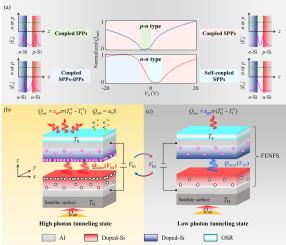半导体场效应近场热控制蒙皮与可调谐发射通过电压控制等离子激元极化子
IF 5.8
2区 工程技术
Q1 ENGINEERING, MECHANICAL
International Journal of Heat and Mass Transfer
Pub Date : 2025-09-06
DOI:10.1016/j.ijheatmasstransfer.2025.127801
引用次数: 0
摘要
变发射率涂层可以在严格的重量和功率限制下管理小卫星的热流和温度调节,但其有限的调谐范围和不连续可调性影响了其整体有效性。本研究提出了两种类型的场效应近场热控制皮肤(FENFS)来解决这些限制:具有相同初始掺杂水平的p-n型和具有不同初始掺杂水平的n-n型。这两种设计都可以通过电压控制的等离子体激元模式转换实现主动和连续的发射率调制。结果表明,在[−3.8,20]V范围内,p-n型的最大发射率可达0.8,在[−12.1,3.2]V范围内,n-n型的最大发射率可达0.7,其中p-n型的发射率可达0.1以下,适合保温。通过施加适当的电压,两种FENFS都能有效地缓解由内外热通量波动引起的卫星表面温度波动,甚至可以将表面温度维持在预设的目标温度。p-n型更适合于低内热通量的情况,而n-n型更适合于高内热通量的情况。本研究提出了小卫星热管理的主动发射率控制策略,拓展了近场辐射传热在航天器系统中的应用。本文章由计算机程序翻译,如有差异,请以英文原文为准。

Semiconductor field-effect near-field thermal control skin with tunable emission via voltage-controlled plasmon polariton
Variable emissivity coatings can manage heat flow and regulate temperature in small satellites operating under strict weight and power constraints, but their limited tuning ranges and discontinuous tunability affect their overall effectiveness. This study proposes two types of field-effect near-field thermal control skins (FENFS) to address these limitations: a p-n type with the same initial doped levels and an n-n type with different initial doped levels. Both designs enable active and continuous emissivity modulation through voltage-controlled plasmon polariton mode conversion. Results show that the maximum emissivity tuning range can reach 0.8 for the p-n type within [−3.8, 20] V and 0.7 for the n-n type within [−12.1, 3.2] V, with the p-n type achieving an emissivity below 0.1, which is suitable for heat preservation. By applying appropriate voltages, both FENFS effectively mitigate satellite surface temperature swings caused by fluctuating internal and external heat fluxes and can even maintain the surface temperature at a preset target temperature. The p-n type is better suited for low internal heat flux scenarios, whereas the n-n type performs better under higher internal heat flux cases. This study advances active emissivity control strategies for small satellite thermal management and expands the application of near-field radiative heat transfer in spacecraft systems.
求助全文
通过发布文献求助,成功后即可免费获取论文全文。
去求助
来源期刊
CiteScore
10.30
自引率
13.50%
发文量
1319
审稿时长
41 days
期刊介绍:
International Journal of Heat and Mass Transfer is the vehicle for the exchange of basic ideas in heat and mass transfer between research workers and engineers throughout the world. It focuses on both analytical and experimental research, with an emphasis on contributions which increase the basic understanding of transfer processes and their application to engineering problems.
Topics include:
-New methods of measuring and/or correlating transport-property data
-Energy engineering
-Environmental applications of heat and/or mass transfer

 求助内容:
求助内容: 应助结果提醒方式:
应助结果提醒方式:


